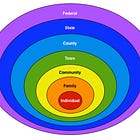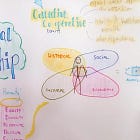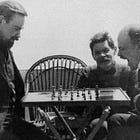What do Ken Wilber, Alexander Bogdanov, and the Bahá’í Faith have in common?
As it turns out, a fair bit more than one might expect.
A Template for the Future
The Bahá’í Faith, founded in the 19th century, employs a system of governance that integrates consultative decision-making with a structured hierarchy. This model aligns with modern global governance frameworks by combining ethical deliberation with regulatory enforcement. Rather than relying solely on legal codes, political authority, or national sovereignty, this system incorporates moral imperatives into governance, ensuring that decision-making follows a structured ethical process while allowing for local adaptation.
The governance structure is neither a theocracy nor a purely decentralised system. It operates through a consultative mechanism, where decision-making is structured around ethical considerations rather than majoritarian politics or administrative bureaucracy. This framework mirrors multi-stakeholder governance models, such as those promoted by the United Nations, UNESCO, and transnational NGOs, where policy decisions are increasingly guided by ethical frameworks rather than conventional legal precedent.
While consultation is the primary decision-making mechanism, the Bahá’í model integrates codified enforcement. Ethical directives, once formalised through consultation, are encoded into binding governance structures, ensuring that decisions are not merely advisory but enforceable. This transition from moral deliberation to regulatory enforcement is comparable to modern global governance institutions, which integrate ethical principles into legally codified frameworks such as the United Nations Sustainable Development Goals (SDGs), international human rights treaties, and climate agreements.
By structuring governance through a combination of ethical consultation and enforceable regulation, the Bahá’í model represents a system where governance, ethics, and law function as interdependent mechanisms. This framework suggests a model of global governance that prioritises moral imperatives over traditional state sovereignty, with laws serving as enforcement mechanisms for ethical directives rather than instruments of political authority. The increasing integration of ethics into transnational governance structures suggests that this model provides a functional blueprint for an emerging system where governance is defined not solely by legal authority but by structured ethical administration.
The Consultative Mechanism
A core component of the Bahá’í governance model is its Consultative Mechanism, which functions as the primary decision-making process across all levels of its hierarchical structure. Rather than operating through democratic voting or unilateral authority, this mechanism follows a structured process designed to achieve consensus based on predefined ethical principles.
The Consultative Mechanism integrates input from multiple governance levels while ensuring centralised oversight. It follows a structured sequence:
Structured Deliberation – Decision-making is conducted through guided discussions where participants contribute perspectives without adversarial debate. The objective is to synthesise viewpoints rather than engage in contestation.
Hierarchical Implementation – Decisions made at lower levels are subject to review, modification, or override by higher governing bodies to ensure alignment with overarching ethical directives.
Codification of Outcomes – Once a consensus is reached, ethical guidelines are formalised into community directives, policies, and governance structures, ensuring compliance and uniform implementation.
Centralised Coordination – All consultative decisions ultimately align with the Universal House of Justice, which maintains system-wide coherence and final authority.
This hierarchical consultation model aligns with contemporary multi-stakeholder governance frameworks, where decision-making authority is distributed across different organisational levels but remains subject to overarching oversight. Similar governance structures are observed in institutions such as the United Nations, UNESCO, and the European Union, where structured consultation informs policy decisions while maintaining alignment with centralised mandates.
By combining structured deliberation with hierarchical governance, the Consultative Mechanism functions as both a decision-making process and an enforcement structure, ensuring that policies formulated through consultation are standardised and enforceable across the entire system.
Moral Encoding
The ethical principles established through the Bahá’í Consultative Mechanism are not limited to governance structures but are systematically integrated into society through religion, education, and cultural institutions. This process of moral encoding ensures that governance extends beyond administrative frameworks, shaping values, beliefs, and behaviours at all levels of social organisation.
This moral encoding functions through several interconnected mechanisms:
Religious Teachings – Ethical principles are framed as divinely ordained imperatives rather than as secular moral constructs, ensuring that governance is perceived as an absolute ethical framework rather than a flexible social agreement.
Education and Ethical Development – Schools and academic institutions serve as primary channels for instilling ethical responsibility, reinforcing moral imperatives from an early age. This aligns with UNESCO’s Global Citizenship Education, which promotes a transition from national identity to planetary identity through structured curriculum-based moral instruction.
Arts and Culture as Vehicles for Ethical Formation – Literature, music, visual arts, and performance act as instruments for reinforcing ethical norms, embedding governance principles into cultural expression and shaping collective identity.
Institutionalised Ethical Governance – Ethical principles are integrated into civil society institutions, ensuring that decision-making processes operate within an explicitly moral framework rather than being guided by purely administrative or legal mechanisms.
This structured moral dissemination closely parallels the United Nations’ approach to cultural and educational governance, where values are propagated through educational policies, artistic initiatives, and civil society engagement. By embedding governance within an ethical framework, the Bahá’í model establishes long-term ideological continuity, ensuring that moral imperatives become self-reinforcing rather than dependent on external enforcement.
Through this systematic integration of governance into religion, education, and culture, ethical norms are internalised as an inherent aspect of social organisation, transforming governance into a pervasive moral order that functions beyond institutional authority. This ensures that governance does not appear as an external force but as a structurally embedded ethical paradigm, continuously reinforced through the cultural and educational landscape.
The Organisational Structure
The Bahá’í Faith operates through a tiered system of ethical governance, structured in a way that resembles contemporary global institutions such as the United Nations, World Bank, and international regulatory bodies. This hierarchical structure ensures that governance remains ethically consistent across all levels, while allowing for local adaptation within the broader framework.
The key components of the Bahá’í governance structure include:
The Universal House of Justice (Global Level) – The highest governing body, responsible for issuing authoritative ethical directives and overseeing global governance matters.
National Spiritual Assemblies (National Level) – These institutions oversee governance at the nation-state level, ensuring that local Bahá’í communities adhere to global ethical principles while maintaining regional coherence.
Local Spiritual Assemblies (Local Level) – These assemblies manage community-level governance, applying ethical directives in local contexts while remaining aligned with national and global mandates.
This hierarchical yet decentralised model closely mirrors modern global governance structures, where:
Ethical standards are set at the global level (similar to UN resolutions or World Bank frameworks).
National bodies function as intermediaries, implementing directives within state-level jurisdictions.
Local institutions ensure policies are applied in practical, community-specific ways.
Additionally, the Bahá’í administrative structure operates without clergy. Instead, governance is structured around consultative decision-making and divine revelation as codified within the faith’s central texts.
This system also prohibits independent spiritual interpretation, ensuring that personal religious perspectives do not diverge from the institutionally sanctioned ethical framework. The result is a structured model of governance that maintains ethical uniformity across all levels while preventing fragmentation or doctrinal deviation.
Centralised Decentralisation
The Bahá’í governance model incorporates the principle of subsidiarity, where decision-making occurs at the lowest possible level, escalating to higher authorities only when necessary. This structure balances local adaptability with overarching ethical cohesion, ensuring that governance remains both responsive and structurally aligned.
The system operates through a tiered process:
Local Autonomy – Communities are responsible for addressing issues independently, applying ethical governance within their immediate cultural and social context.
National Coordination – National assemblies oversee governance at the state level, ensuring that local policies align with global directives while allowing for some regional flexibility.
Global Oversight and Authority – The Universal House of Justice serves as the supreme authority, ensuring that all levels of governance remain aligned with universal moral imperatives.
Despite its decentralised structure, the subsidiarity principle operates within strict hierarchical constraints. Any decision made at the local or national level is ultimately subject to review, appeal, or override by higher authorities. This ensures that while lower levels of governance have an operational role, they do not possess final authority—a model that mirrors many contemporary international institutions, including the United Nations, the European Union, and global financial regulatory bodies.
Although subsidiarity may appear to enable decentralisation, its application remains contingent on the approval of higher governance bodies. This structure maintains the illusion of local decision-making autonomy while ensuring that all governance decisions remain aligned with centralised ethical mandates. The result is a system where perhaps some level of local responsiveness is permitted.
Global Ethical Governance
The Bahá’í governance model is not an isolated system—it aligns with contemporary trends in ethics-driven global governance, particularly those promoted by institutions such as the United Nations, UNESCO, and transnational organisations. At its core, this model represents a shift from national sovereignty to global governance shaped by moral imperatives, positioning ethical responsibility as the guiding principle in decision-making. This reflects a broader movement toward post-national, multi-stakeholder governance, where legal frameworks are increasingly shaped by ethical considerations rather than state authority.
Several structural and ideological parallels illustrate this alignment:
Ethics-Based Governance – The Bahá’í model, like UNESCO’s Universal Declaration on Bioethics, prioritises moral imperatives over rigid legalism, ensuring that governance is ethically guided.
Global Citizenship & Post-National Identity – The Bahá’í concept of world citizenship aligns with UNESCO’s Global Citizenship Education, reinforcing the transition from national to planetary identity as the primary unit of governance.
Peacebuilding & Demilitarisation – The Bahá’í model promotes conflict resolution through consultation, resembling UN Peacekeeping and Disarmament Programs, which gradually shift reliance away from military force toward ethical diplomacy.
Economic Justice & Wealth Redistribution – In line with World Bank and UNDP initiatives, the Bahá’í system frames wealth redistribution as an ethical responsibility, advocating for stakeholder capitalism and financial equity.
Environmental Responsibility – Reflecting SDG 13 (Climate Action) and the Earth Charter, the Bahá’í worldview integrates sustainability as a moral duty, ensuring environmental policies are based on ethical principles rather than economic incentives.
Religious & Interfaith Dialogue – The Bahá’í emphasis on religious unity corresponds with UNESCO’s Cultural Heritage Protection and interfaith initiatives, embedding spiritual ethics within global governance structures.
This structural alignment is not incidental but reflects a shared trajectory toward ethics-driven governance, where religious, cultural, and technological structures are synthesised into a cohesive moral framework. In this regard, the Bahá’í model serves as a blueprint for governance systems that fuse ethical imperatives with structured decision-making, contributing to a broader transformation of governance principles across global institutions.
However, this model does not function in isolation. Its structure, decision-making process, and moral codification mechanisms align with historical governance models rooted in scientific organisation and systemic control. To fully understand how these principles transition from ethical governance to systemic regulation, we must examine the structural theories of Alexander Bogdanov.
Alexander Bogdanov
The Bahá’í governance model, with the Universal House of Justice at its apex, overseeing decision-making through the Consultative Mechanism, exhibits structural similarities to Alexander Bogdanov’s theories of organisation and control. As a key figure in early Soviet organisational thought, Bogdanov developed Empiriomonism, Tektology, and Proletkult, each of which reflects fundamental aspects of hierarchical governance, cultural encoding, and systemic regulation—all present within the Bahá’í administrative order.
Bogdanov’s theories were not designed as abstract philosophical frameworks but as practical models for governance, integrating political structure, economic coordination, and ideological conditioning into a single, self-regulating system. His goal was to create an adaptive mechanism, where governance could be standardised, stabilised, and refined through systemic feedback loops, top-down coordination, and epistemological control. The Bahá’í model exhibits these same characteristics, blending hierarchical decision-making with structured moral enforcement, ensuring ideological continuity across all levels of administration.
The Consultative Mechanism and Empiriomonism
Bogdanov’s Empiriomonism sought to establish a unified organisational method based on collective reasoning and structured consultation. Unlike models that prioritise individual autonomy, Empiriomonism emphasised decisions derived from an overarching systemic logic, ensuring that subjective viewpoints did not interfere with structural coherence.
The Bahá’í Consultative Mechanism follows this same principle, replacing majoritarian democracy with a structured ethical process, where governance is determined through predefined moral imperatives rather than adversarial debate.
Structured Consensus Over Individual Autonomy – Just as Empiriomonism prioritised collective reasoning over subjective opinion, the Bahá’í model ensures that governance decisions follow a predefined ethical trajectory, minimising ideological fragmentation.
Centralised Coordination – In both frameworks, decision-making is hierarchically structured, funnelling authority and validation upward. Bogdanov’s scientific governance body mirrors the Bahá’í system, where the Universal House of Justice retains ultimate authority, ensuring top-down ethical enforcement.
This structure guarantees that governance decisions align with overarching directives, preventing local or individual deviations from the established moral framework.
Moral Encoding and Proletkult
A critical aspect of Bogdanov’s Proletkult was its role in shaping ideological consciousness through education, culture, and the arts. Proletkult was not simply about artistic expression—it was a deliberate mechanism for embedding ideological values into society’s cultural fabric.
The Bahá’í system functions in a similar way, ensuring that ethical governance is not confined to legislative structures but is embedded within religion, education, and cultural production.
Directed Cultural Development – Proletkult ensured that culture was not an independent force but a reinforcement mechanism for governance. The Bahá’í model mirrors this, embedding ethical imperatives into arts, education, and religious teachings.
Ethical Convergence – Bogdanov’s Proletkult ensured that ideological values remained coherent across all cultural expressions. Similarly, the Bahá’í moral framework standardises ethical messaging, ensuring that education, religious doctrine, and the arts reinforce the same governance structure.
Rather than allowing for spontaneous cultural evolution, both Proletkult and the Bahá’í system utilise structured ideological encoding, ensuring long-term continuity of governance values.
Organisational Structure and Tektology
Bogdanov’s Tektology, often regarded as a precursor to general systems theory, proposed a universal model of organisation that could be applied to governance, economic planning, and ideological control. It outlined how self-regulating hierarchical systems could maintain stability through recursive feedback loops.
The Bahá’í governance model follows this systems-based logic, integrating hierarchical coordination, adaptive subsidiarity, and top-down oversight.
Hierarchical Structure with Recursive Control – Tektology proposed a nested governance model, where each organisational level integrates seamlessly into the next. The Bahá’í model follows the same logic:
Local Assemblies function as subsidiary nodes, responsible for implementing ethical governance at the community level.
National Assemblies act as mid-tier coordinators, ensuring that regional policies align with overarching directives.
The Universal House of Justice serves as the central authority, maintaining top-down control over ethical governance.
Governance as a Self-Regulating System – In both Tektology and the Bahá’í model, lower governance levels appear autonomous but remain structurally constrained. Higher levels retain authority to override decisions, ensuring that local governance never deviates from central directives.
Ultimately, the Bahá’í model aligns with Bogdanov’s vision of a scientific, hierarchical governance system, where ideological coherence is maintained through structured consultation, cultural encoding, and top-down coordination. This convergence of systemic organisation and moral governance forms the foundation of a self-perpetuating governance structure, where ethics, ideology, and administration operate as a singular, unified mechanism.
Ken Wilber
Ken Wilber’s Integral Metatheory provides a framework for understanding governance structures through three interrelated dimensions: vertical organisation, horizontal progression, and depth perspective. Unlike earlier iterations of Integral Theory, which primarily examined the relationship between individuals and collectives over time, Integral Metatheory introduces an additional epistemological axis—depth perspective—which defines how governance structures shape subjective and objective interpretations of reality.
This expanded model offers a systemic perspective on governance, not only as a hierarchical structure or a trajectory of ideological evolution, but also as a mechanism for perception management.
The Hierarchy of Governance
Governance structures operate hierarchically, with higher levels overseeing and directing lower levels. This hierarchical model is reflected in the Bahá’í system, where governance is structured as follows:
The Universal House of Justice (Global Level) – Acts as the supreme authority, issuing binding ethical directives.
National Spiritual Assemblies (National Level) – Implement governance policies at the state level, ensuring alignment with global ethical imperatives.
Local Spiritual Assemblies (Local Level) – Execute decisions at the community level, reinforcing moral governance in daily life.
This tiered structure mirrors Wilber’s individual-group hierarchy, where governance progresses from self to community to planetary leadership, with each level subordinated to and directed by the one above.
A similar structural principle underlies Bogdanov’s Tektology, where systemic cohesion is preserved by ensuring that each level integrates into the next in a recursive governance model.
Governance as Ideological Evolution
Wilber’s horizontal axis represents ideological development over time, where governance frameworks evolve in response to shifting ethical paradigms. The Bahá’í system aligns with this principle by encoding ethical directives into structured moral education, ensuring a gradual but directed progression toward a unified global ethic.
This ideological development is reinforced through:
Religious Doctrine – Moral law is framed as spiritual law, ensuring adherence through ethical obligation rather than political coercion.
Education Systems – Ethical frameworks are embedded in formal education, aligning with global curricula such as UNESCO’s Global Citizenship Education.
Arts and Cultural Production – Governance principles are reinforced through creative expression, integrating moral imperatives into literature, music, and visual culture.
This process aligns with Bogdanov’s Proletkult, where cultural and artistic production was used as a mechanism for ideological conditioning, ensuring that governance remained harmonised with a predefined ethical end-state.
Controlling the Interpretation of Reality
The final dimension in Wilber’s model—depth perspective—examines how governance frameworks shape interpretation itself, controlling how reality is perceived.
The Bahá’í system operates within this paradigm, ensuring that all decision-making processes are filtered through a predefined ethical lens with the Universal House of Justice being the ultimate authority.
Consultative Decision-Making – Ethical and policy decisions must align with hierarchical consensus, limiting interpretive deviation.
No Independent Spiritual Investigation – Moral interpretation is centralised, preventing alternative perspectives from challenging the governance structure.
A Structured Perception of Reality – Governance is not justified through open discourse, but through institutional authority, ensuring that knowledge, ethics, and governance remain structurally interwoven.
This epistemological structuring parallels Bogdanov’s Empiriomonism, where the interpretation of reality is not neutral, but interpreted through a collectively-subjective lens, ensuring ideology, ethics, and administration remain synchronised.
Integral Metatheory and Moral Globalism
By applying Integral Metatheory to the Bahá’í governance model, a structured logic emerges, showing how governance functions as an interdependent system:
Governance is vertically structured through a hierarchical decision-making framework (Vertical Organisation).
Moral ideology is conditioned over time through education, religion, and cultural encoding (Horizontal Progression).
The governance structure controls interpretation itself, ensuring that reality is perceived subjectively through a collective understanding (Depth Perspective).
The mechanics of Wilber’s three-dimensional model do not apply only to the Bahá’í model—they are also reflected in earlier systems-based governance theories, reinforcing the broader idea that moral globalism functions as a structured, systemic process of governance, social development, and epistemological control.
Within this integrated framework, the Bahá’í model emerges as an idealised system, where governance (vertical organisation), ideological conditioning (horizontal progression), and interpretive control (depth perspective) are interwoven into a singular, self-reinforcing mechanism.
Through this approach, governance moves beyond ethical imperatives, evolving into a self-sustaining system of ideological reinforcement and cybernetic control. This model is not merely theoretical—it is an actively evolving governance system, reinforced by adaptive feedback loops, structured enforcement mechanisms, and algorithmic oversight.
Three Models Interwoven
The Bahá’í governance model, Ken Wilber’s Integral Metatheory, and Alexander Bogdanov’s systems approach are not independent frameworks. Rather, they function as interwoven mechanisms, collectively forming a unified model of governance, ideological reinforcement, and systemic control. Each contributes to a multi-layered structure, where governance is externally imposed, internally justified, and technologically managed. Together, they outline the blueprint for a global governance system promising to take us to the Omega Point, sustained through hierarchical control, ideological conditioning, and cybernetic oversight.
Externally Imposed World Order
The Bahá’í system provides a structural model for global governance, closely aligning with United Nations frameworks, Sustainable Development Goals (SDGs), and multi-stakeholder governance models. This model operates through centralised ethical governance, where moral imperatives replace political authority as the basis for decision-making.
Key mechanisms of external governance include:
Top-down authority – The Universal House of Justice functions as the ultimate decision-making body, issuing binding ethical directives that shape governance across all levels.
Subsidiarity with top-down override – While governance appears decentralised, higher levels retain the ability to override lower decisions, mirroring structures like the IMF, World Bank, and UN, where national policies are implemented within a broader global mandate.
Ethical governance replacing legalism – Morality, rather than legal precedent, serves as the foundation for governance, ensuring adaptability while maintaining strict ideological coherence.
This model illustrates how an externally imposed global governance framework could function—where laws emerge not as instruments of state power, but as enforcement mechanisms for ethical imperatives.
Internal Self-Justification
Wilber’s Integral Metatheory does not impose governance externally—instead, it conditions individuals to internalise governance structures as part of an inevitable moral and intellectual evolution. By structuring perception and belief systems, Wilber’s model reinforces compliance without requiring direct enforcement.
The three axes of Integral Metatheory establish the psychological and epistemological conditions necessary for widespread acceptance:
Vertical organisation – Justifies hierarchical governance as a natural evolutionary process, making top-down control appear beneficial and necessary.
Horizontal progression – Frames ethical governance as the inevitable trajectory of human development, ensuring that ideological conditioning through religion, education, and culture appears as progress rather than control.
Depth perspective – Shapes interpretation itself, ensuring that all information is filtered through an ethical framework, preventing alternative ideological structures from emerging.
By structuring thought and perception, Wilber’s framework ensures that governance is not just passively accepted, but actively defended by those subject to it. Governance becomes not an external imposition, but an internalised worldview.
AI, Adaptive Management, and Cybernetic Control
While the Bahá’í model structures governance and Wilber’s framework secures ideological compliance, Bogdanov’s systems theory provides the technological and organisational mechanisms for implementation.
Bogdanov’s Tektology, Empiriomonism, and Proletkult enable governance to scale into a fully automated system, managed through cybernetic oversight and adaptive feedback loops.
Key features of systems-based governance include:
Tektology (General Organisational Science) – Structures governance into an interconnected, self-replicating system, ensuring stability across all levels.
Empiriomonism (Epistemological Control) – Ensures that knowledge production and decision-making processes are structured within a single governing system, making ideological deviation functionally impossible.
Proletkult (Cultural Engineering) – Embeds governance principles into cultural production, ensuring that arts, media, and education reinforce governance structures rather than challenging them.
When fused with modern AI, cybernetics, and real-time surveillance, this framework enables adaptive governance, where:
AI continuously monitors compliance at all levels.
Cybernetic systems dynamically adjust policies, optimising efficiency while maintaining strict adherence to moral imperatives.
Decision-making is increasingly automated, shifting governance from human administrators to self-regulating algorithmic systems.
This integration of systems science, cybernetics, and AI-driven management produces a governance framework that is no longer purely hierarchical, but self-regulating, self-correcting, and continuously evolving toward greater ideological cohesion.
Moral Globalism as Total Governance
When combined, these three models create a fully integrated system of global control:
The Bahá’í governance model structures the external world order, ensuring hierarchical control under the pretense of ethical subsidiarity.
Ken Wilber’s Integral Metatheory conditions internal self-justification, ensuring widespread compliance through ideological framing.
Bogdanov’s systems approach enables cybernetic and AI implementation, ensuring real-time enforcement through adaptive management and technological oversight.
This synthesis represents not just governance, but a total system of control, where external structures, internal belief systems, and technological enforcement mechanisms function as a single, unified mechanism.
If fully realised, such a system would mean that global governance is no longer merely a function of policy or law, but an ethically justified, self-sustaining, and technologically managed order—where compliance is not only enforced, but structured into the very fabric of human experience.
Historical Precedents and Structural Risks
The integration of ethics into governance—particularly when fused with legislation and enforcement mechanisms—has repeatedly led to authoritarian outcomes throughout history. While ethical governance frameworks claim to transcend the coercive nature of traditional political systems, they have often resulted in centralised power structures, suppression of dissent, and large-scale social engineering.
The fusion of moral imperatives with enforceable governance has historically been a hallmark of totalitarianism. Attempts to establish governance systems based on moral correctness rather than legal codification alone have led to regimes where the ends justify the means, often resulting in mass persecution, economic collapse, and systemic human rights abuses.
Notable historical parallels include:
Soviet Ethical Governance – The Bolsheviks' fusion of morality and law sought to create a just society, yet ultimately led to mass purges, forced collectivisation, and the deaths of millions under Stalin’s rule.
Maoist Moral Governance – The Cultural Revolution framed governance as a moral struggle, leading to widespread persecution, ideological purges, and mass executions.
Nazi Germany’s Volksgemeinschaft – Governance was based on the moral imperative of racial purity and national destiny, resulting in the legal codification of genocide.
Theocratic Dictatorships – Regimes such as Iran’s post-revolutionary government fused religious ethics with governance, leading to rigid authoritarian control and severe restrictions on personal freedoms.
Each of these cases demonstrates that governance systems justified through moral imperatives—especially when paired with enforceable legislative frameworks—can lead to severe oppression, arbitrary rule, and even genocide, particularly when dissent is framed as immoral rather than as a legitimate political stance.
A Recurring Pattern in Governance Theory
While the Bahá’í Consultative Mechanism is presented as a distinct governance innovation, it is structurally identical to models proposed by figures who laid the groundwork for multi-stakeholder governance and adaptive management systems. The same core consultative process has been advocated by socialist, corporate, and technocratic theorists across different historical and ideological contexts.
Key precedents include:
Julius Wolf (1892 Gold Clearance Mechanism, precursor to the BIS) – Developed a financial governance model where gold transactions were managed through a centralised clearance system, eliminating the need for physical transfers. This mechanism, later adapted by the Bank for International Settlements (BIS), pioneered financial globalisation, demonstrating how international consultation and structured oversight could replace national monetary policies.
Eduard Bernstein (Revisionist Marxism, 1899) – Proposed an evolutionary socialist approach, where governance shifts from legal enforcement to consultative consensus, ensuring that moral and economic forces guide policy decisions.
Leonard S. Woolf (Fabian Socialist & Internationalist, 1916) – Advocated for a technocratic, multi-sectoral governance model, where decision-making was increasingly shifted away from sovereign nations, to international organisations.
Lenin’s New Economic Policy (NEP, 1921–1928) – Merged consultative governance with controlled market mechanisms, resulting in a system where state control persisted beneath a facade of stakeholder-driven economic policy.
Tony Blair’s Third Way (1990s–2000s) – Developed a governance model where public-private partnerships, civil society, and regulatory institutions engaged in structured consultation, creating a governance framework that operated to facilitate the common good, with economic and legal mechanisms.
Wolfgang Reinicke’s Tri-Sectoral Networks (2000s–Present) – Advocates for a post-national governance model, where governance shifts away from nation-states and into networks of global institutions, corporations, and NGOs, all operating under a consultative decision-making framework.
Each of these approaches presents consultative, ethics-based governance as a progressive alternative to traditional state sovereignty. However, they share common structural flaws—once moral imperatives are fused with legal enforcement mechanisms, governance ceases to be negotiable and instead becomes an instrument of ideological conformity, while also shifting power away from democratically accountable entities.
A Path to Algorithmic Control
As governance transitions from legal precedent to ethical justification, the risks of authoritarian enforcement mechanisms increase, particularly when combined with AI, cybernetics, and surveillance technologies. In historical authoritarian regimes, mass control required physical coercion, but in modern governance frameworks, compliance is increasingly ensured through technological oversight, predictive analytics, and automated decision-making.
The fusion of ethics, consultative governance, and algorithmic enforcement risks creating a global governance model where:
Moral imperatives become non-negotiable mandates, enforced through real-time data monitoring.
Dissent is classified as a deviation from ethical governance, rather than as a political position.
Algorithmic governance dynamically adjusts policies, eliminating the need for traditional democratic oversight.
Digital identity systems monitor compliance, ensuring that individual behaviour aligns with global ethical mandates.
The historical trajectory of ethics-based governance models suggests that moral imperatives, when institutionalised through consultation, law, and technological enforcement, do not lead to greater freedom, but instead create self-reinforcing governance systems that erode personal agency in favour of ideological conformity.
If this governance structure continues to evolve through consultative mechanisms, moral imperatives, and AI-driven oversight, it risks achieving full systemic integration, potentially resulting in a governance model that is not merely authoritarian, but algorithmically self-perpetuating.
Governance Without Exit
One of the key dangers of a global ethics-driven governance system is the elimination of exit options. Unlike previous governance models, which allowed citizens to challenge, reform, or flee from oppressive regimes, a technologically-integrated ethics-based system, reinforced by digital identity frameworks and AI oversight, could close off avenues for resistance, appeal or alternative governance structures.
This shift represents a break from historical governance models, where oppressive regimes were ultimately unsustainable due to internal inefficiencies, economic stagnation, or external opposition. In contrast, a cybernetically-managed governance system would continuously self-correct, adjusting policies in real-time based on algorithmic predictions of dissent.
If realised, this model would not require coercion in the traditional sense. Instead, it would function as a self-regulating system, where governance, ethics, and AI-driven oversight merge into a single, adaptive control mechanism—ensuring universal compliance not through force, but through systemic inevitability.
This is the logical endpoint of a governance system where ethics replaces law, consultation replaces democracy, and cybernetic management replaces political negotiation.
Conclusion
At its foundation, moral globalism represents a fundamental shift—one in which governance ceases to function through law and political authority alone and instead becomes a system of ideological conditioning, structured ethical mandates, and self-reinforcing control mechanisms. This transformation is evident across multiple domains: the hierarchical moral governance of the Bahá’í model, the epistemological structuring of Wilber’s Integral Metatheory, and the cybernetic systems architecture found in Bogdanov’s organisational science. These models, when combined, construct a governance paradigm that is neither purely political nor purely ethical, but instead operates as a fully integrated socio-technical system.
This governance framework does not require overt coercion or even universal consensus. Instead, it embeds compliance within the system itself. The shift from law to ethics, from politics to consultation, and from enforcement to systemic conditioning ensures that governance is internalised as a moral duty, rather than experienced as an external imposition. Through structured moral education, consultative consensus, and cultural encoding, the system becomes self-perpetuating—decisions appear inevitable, rather than imposed.
The risks of such a system are not hypothetical. History has demonstrated that when governance fuses ethics with legislative enforcement, the result is often authoritarianism disguised as moral progress. The consultative decision-making structures underpinning this transformation are not new—they follow a trajectory pioneered by Julius Wolf’s financial governance mechanisms, Eduard Bernstein’s socialist revisions, Leonard Woolf’s International Government, Lenin’s New Economic Policy, Blair’s Third Way, and Wolfgang Reinicke’s Trisectoral Networks. These precedents reveal that consultation, when paired with ethical mandates and legal enforcement, often functions as a mechanism for consolidating control rather than promoting genuine decentralisation.
Modern developments remove the historical limitations of these earlier models. In the past, authoritarian ethical governance systems collapsed due to inefficiencies, economic stagnation, or external resistance. However, the integration of artificial intelligence, real-time surveillance, and adaptive management now enables a continuously self-correcting system—one that can anticipate, manage, and neutralise dissent before it emerges. The fusion of global ethics with cybernetic governance transforms governance into a closed-loop system, where digital identity frameworks, predictive AI, and stakeholder consultation create a model of control that is both comprehensive and self-sustaining.
This is the final convergence of ethics, governance, and technology—where individual agency dissolves into a planetary architecture of moral imperatives, algorithmic oversight, and self-adjusting systemic governance. What begins as consultative ethics-based governance evolves into a cybernetic structure that no longer merely influences reality—it defines it.
This is not just a new form of governance. It is a totalising epistemological framework, an evolving self-regulating mechanism, and a cybernetically-enforced ethical order.
It is, in every sense, Cybernetic Thomism.














What you describe is in many ways what we are already living through. Witness local councils being unable to stop the government from building all over their green fields.
And during the Covid 19 saga, there was lot of moral pressure to do the 'right thing'. Technology will only facilitate the plans that have been around for a long time.
I find it stifling but am interested in your comment "In contrast, a cybernetically-managed governance system would continuously self-correct, adjusting policies in real-time based on algorithmic predictions of dissent". Does that mean that if enough of us dissent, they will change their plans? Or just bide their time and manipulate opinion?
Great analysis, as always. Global techies and billionaires trying to increase their control, aim their 'ethics' at middle classes, the salaried and literate. They are oblivious to the lives, needs and reality of the very poor, the resource-diggers, the illiterate and powerless. That is why their plans will come to nothing; the middle classes don't agree to being bossed about and the very poor are outside the 'ethics' paradigm.